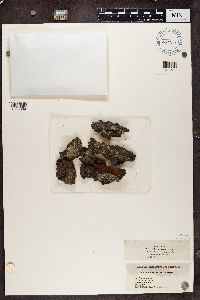University of Minnesota
http://www.umn.edu/
612-625-5000
http://www.umn.edu/
612-625-5000
Minnesota Biodiversity Atlas
Bell Museum
Dataset: MIN-Lichens
Search Criteria: United States OR USA OR U.S.A. OR United States of America; Wisconsin; Green; excluding cultivated/captive occurrences
1
Page 1, records 1-12 of 12
Bell Museum lichens | |
MIN:Lichens | Caloplaca sideritis (Tuck.) Zahlbr. 881147[]Thomson, J. 245991949-09-24 United States, Wisconsin, Green, 1 Mi S of County Line, 42.850211 -89.593798 |
MIN:Lichens | Allarthonia caesia (Flot.) Zahlbr. 437756[1386099]Thomson, J.W. United States, Wisconsin, Green |
MIN:Lichens | Candelaria fibrosa (Fr.) Müll. Arg. 659393[]Thomson, J. 26131945-06-08 United States, Wisconsin, Green Lake, Green Lake, 43.84 -88.96 |
MIN:Lichens | 660757[]Thomson, J. 23491946-09-13 United States, Wisconsin, Green Lake, Lawsonia, Green Lake, 43.813823 -89.036827 |
MIN:Lichens | Physcia aipolia (Ehrh. Ex Humb.) Fürnr. 661760[]Thomson, J. 26201945-06-08 United States, Wisconsin, Green Lake, Green Lake, 43.84 -88.96 |
MIN:Lichens | Physcia millegrana Degel. 661761[]Thomson, J. 20811946-09-13 United States, Wisconsin, Green Lake, Green Lake, 43.79 -89.03 |
MIN:Lichens | 661954[]Thomson, J. 178631973-10-20 United States, Wisconsin, Green Lake, Markesan, E of, 43.728008 -88.895243 |
MIN:Lichens | Cladonia verticillata (Hoffm.) Schaer. 661957[]Thomson, J. 178531973-10-20 United States, Wisconsin, Green Lake, Markesan, E of, 43.728008 -88.895243 |
MIN:Lichens | Physcia subtilis Degel. 661982[]Thomson, J. 178601973-10-20 United States, Wisconsin, Green Lake, Markesan, E of, 43.72 -88.89 |
MIN:Lichens | Porpidia crustulata (Ach.) Hertel & Knoph 661984[]Thomson, J. 178591973-10-20 United States, Wisconsin, Green Lake, Markesan, E of, 43.728008 -88.895243 |
MIN:Lichens | Xanthoparmelia cumberlandia (Gyeln.) Hale 662003[]Thomson, J. 178391973-10-20 United States, Wisconsin, Green Lake, Markesan, E of, 43.72 -88.89 |
MIN:Lichens | Xanthoparmelia plittii (Gyeln.) Hale 662011[]Thomson, J. 178381973-10-20 United States, Wisconsin, Green Lake, Markesan, E of, 43.72 -88.89 |
1
Page 1, records 1-12 of 12
Google Map
Google Maps is a web mapping service provided by Google that features a map that users can pan (by dragging the mouse) and zoom (by using the mouse wheel). Collection points are displayed as colored markers that when clicked on, displays the full information for that collection. When multiple species are queried (separated by semi-colons), different colored markers denote each individual species.
